Factors Influencing the International Marketing Environment Essay
VerifiedAdded on 2020/01/28
|8
|1912
|51
Essay
AI Summary
This essay provides a comprehensive overview of the international marketing environment, examining the factors and forces that shape business operations across national boundaries. It delves into the impact of political, economic, social, technological, ethical, and legal factors on marketing activities. The essay highlights the importance of understanding cultural and social differences, using examples like Coca-Cola and McDonald's to illustrate the need for adaptation in international markets. It further explores the influence of both macro and micro environmental factors, including customers, competitors, and suppliers. The analysis emphasizes the significance of cross-cultural marketing, communication, and language barriers. The essay also discusses how economic factors like inflation and interest rates influence pricing strategies and consumer behavior. In conclusion, the essay stresses the necessity for firms to conduct thorough market analysis and adapt their strategies to succeed in the international marketing landscape. The essay also mentions the importance of legal and ethical frameworks and their impact on international companies and employees.
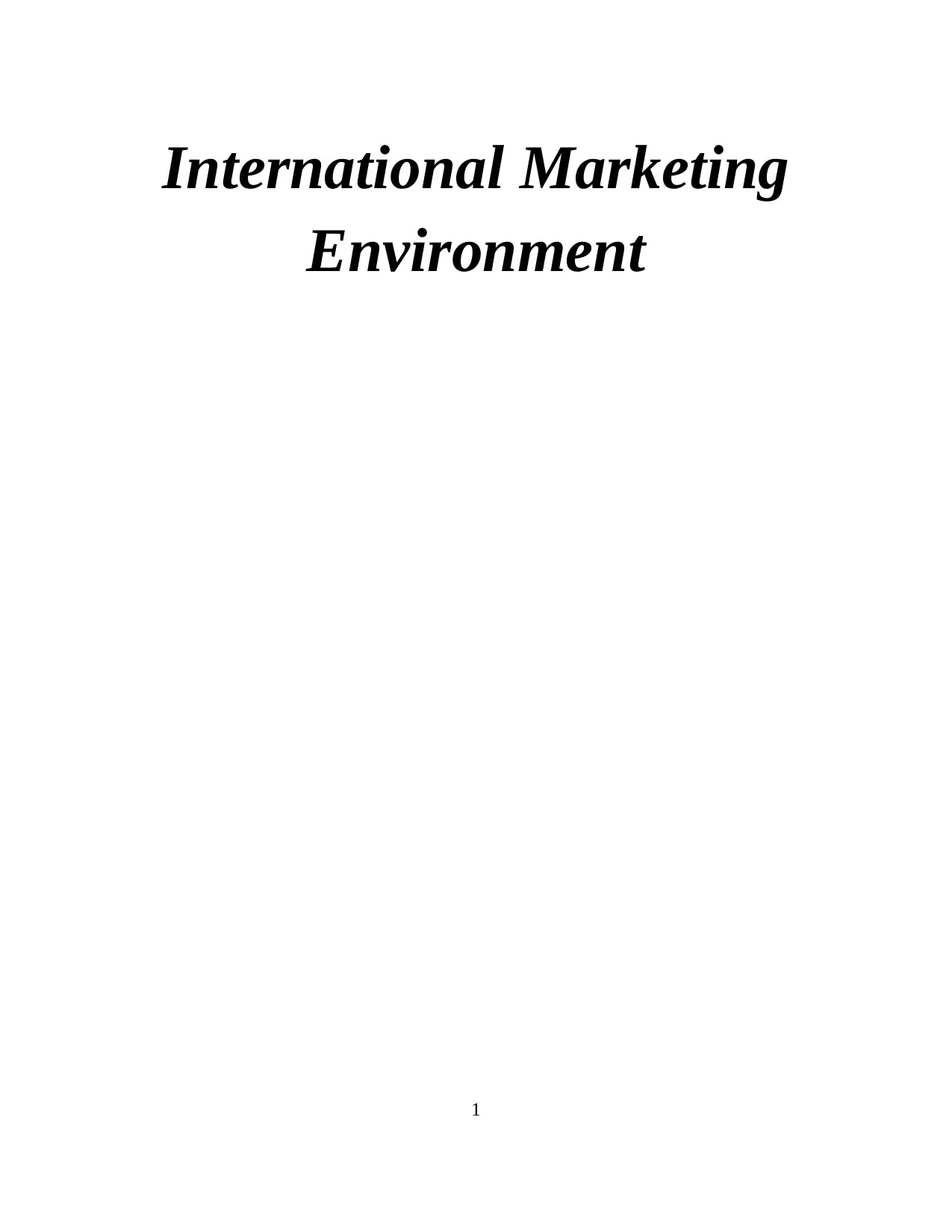
International Marketing
Environment
1
Environment
1
Paraphrase This Document
Need a fresh take? Get an instant paraphrase of this document with our AI Paraphraser
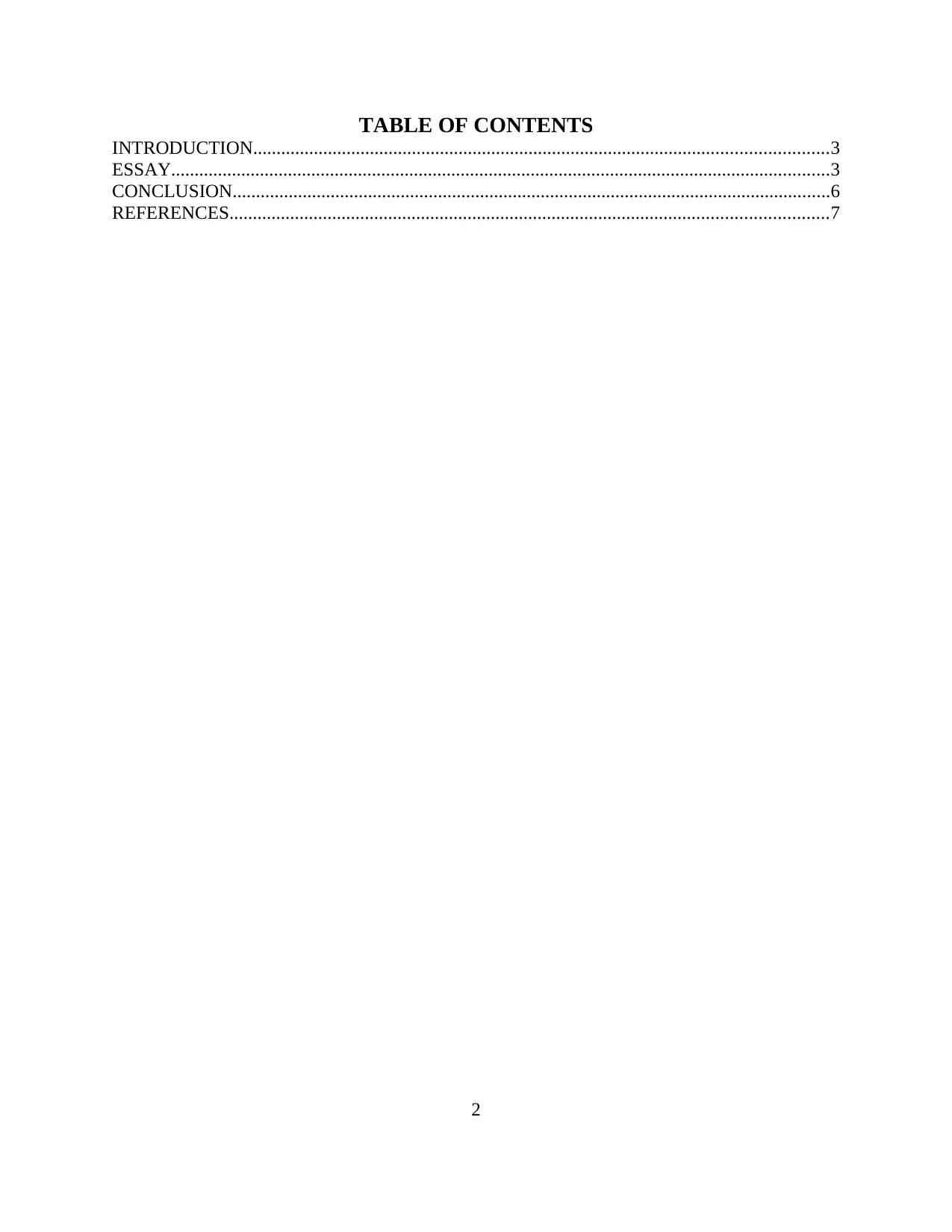
TABLE OF CONTENTS
INTRODUCTION...........................................................................................................................3
ESSAY.............................................................................................................................................3
CONCLUSION................................................................................................................................6
REFERENCES................................................................................................................................7
2
INTRODUCTION...........................................................................................................................3
ESSAY.............................................................................................................................................3
CONCLUSION................................................................................................................................6
REFERENCES................................................................................................................................7
2
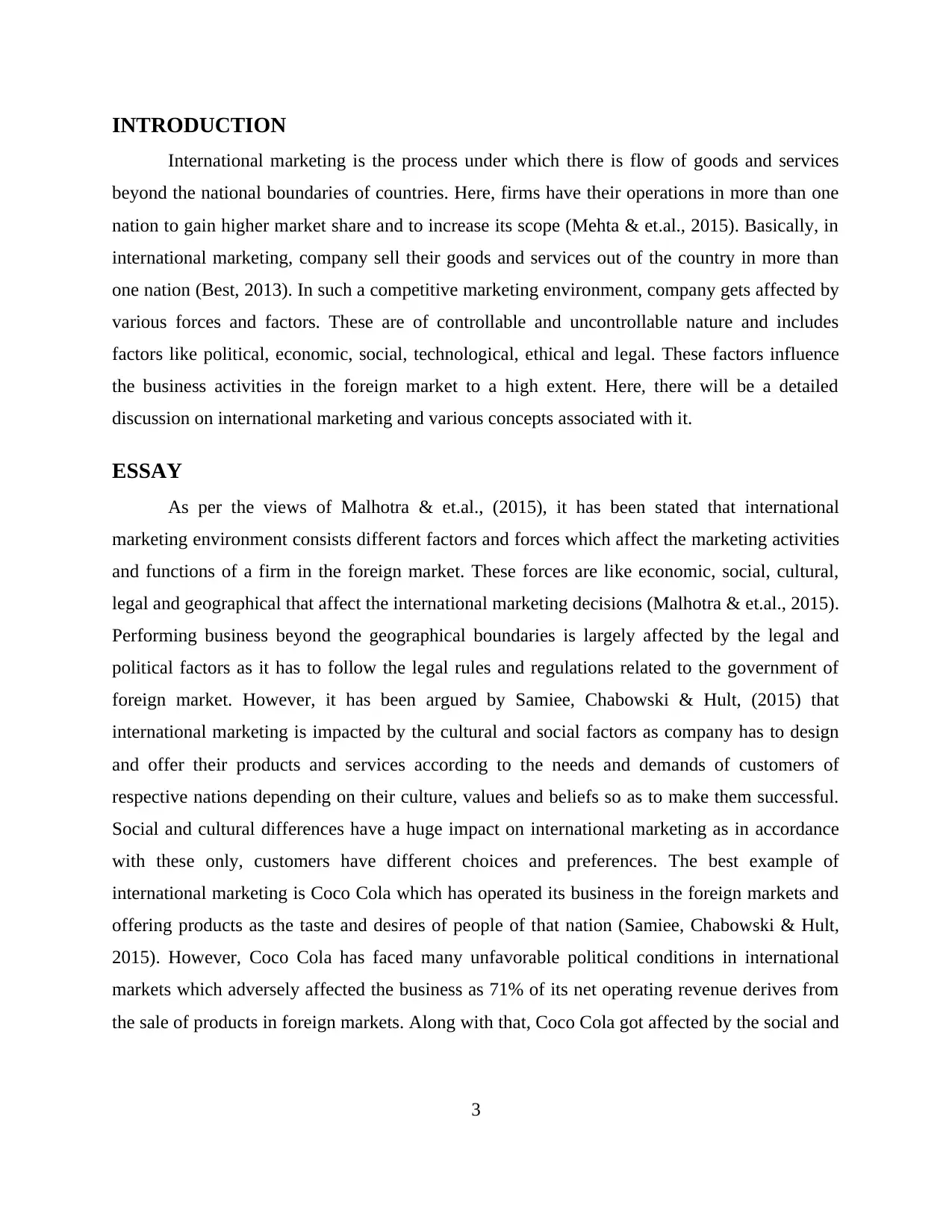
INTRODUCTION
International marketing is the process under which there is flow of goods and services
beyond the national boundaries of countries. Here, firms have their operations in more than one
nation to gain higher market share and to increase its scope (Mehta & et.al., 2015). Basically, in
international marketing, company sell their goods and services out of the country in more than
one nation (Best, 2013). In such a competitive marketing environment, company gets affected by
various forces and factors. These are of controllable and uncontrollable nature and includes
factors like political, economic, social, technological, ethical and legal. These factors influence
the business activities in the foreign market to a high extent. Here, there will be a detailed
discussion on international marketing and various concepts associated with it.
ESSAY
As per the views of Malhotra & et.al., (2015), it has been stated that international
marketing environment consists different factors and forces which affect the marketing activities
and functions of a firm in the foreign market. These forces are like economic, social, cultural,
legal and geographical that affect the international marketing decisions (Malhotra & et.al., 2015).
Performing business beyond the geographical boundaries is largely affected by the legal and
political factors as it has to follow the legal rules and regulations related to the government of
foreign market. However, it has been argued by Samiee, Chabowski & Hult, (2015) that
international marketing is impacted by the cultural and social factors as company has to design
and offer their products and services according to the needs and demands of customers of
respective nations depending on their culture, values and beliefs so as to make them successful.
Social and cultural differences have a huge impact on international marketing as in accordance
with these only, customers have different choices and preferences. The best example of
international marketing is Coco Cola which has operated its business in the foreign markets and
offering products as the taste and desires of people of that nation (Samiee, Chabowski & Hult,
2015). However, Coco Cola has faced many unfavorable political conditions in international
markets which adversely affected the business as 71% of its net operating revenue derives from
the sale of products in foreign markets. Along with that, Coco Cola got affected by the social and
3
International marketing is the process under which there is flow of goods and services
beyond the national boundaries of countries. Here, firms have their operations in more than one
nation to gain higher market share and to increase its scope (Mehta & et.al., 2015). Basically, in
international marketing, company sell their goods and services out of the country in more than
one nation (Best, 2013). In such a competitive marketing environment, company gets affected by
various forces and factors. These are of controllable and uncontrollable nature and includes
factors like political, economic, social, technological, ethical and legal. These factors influence
the business activities in the foreign market to a high extent. Here, there will be a detailed
discussion on international marketing and various concepts associated with it.
ESSAY
As per the views of Malhotra & et.al., (2015), it has been stated that international
marketing environment consists different factors and forces which affect the marketing activities
and functions of a firm in the foreign market. These forces are like economic, social, cultural,
legal and geographical that affect the international marketing decisions (Malhotra & et.al., 2015).
Performing business beyond the geographical boundaries is largely affected by the legal and
political factors as it has to follow the legal rules and regulations related to the government of
foreign market. However, it has been argued by Samiee, Chabowski & Hult, (2015) that
international marketing is impacted by the cultural and social factors as company has to design
and offer their products and services according to the needs and demands of customers of
respective nations depending on their culture, values and beliefs so as to make them successful.
Social and cultural differences have a huge impact on international marketing as in accordance
with these only, customers have different choices and preferences. The best example of
international marketing is Coco Cola which has operated its business in the foreign markets and
offering products as the taste and desires of people of that nation (Samiee, Chabowski & Hult,
2015). However, Coco Cola has faced many unfavorable political conditions in international
markets which adversely affected the business as 71% of its net operating revenue derives from
the sale of products in foreign markets. Along with that, Coco Cola got affected by the social and
3
⊘ This is a preview!⊘
Do you want full access?
Subscribe today to unlock all pages.

Trusted by 1+ million students worldwide
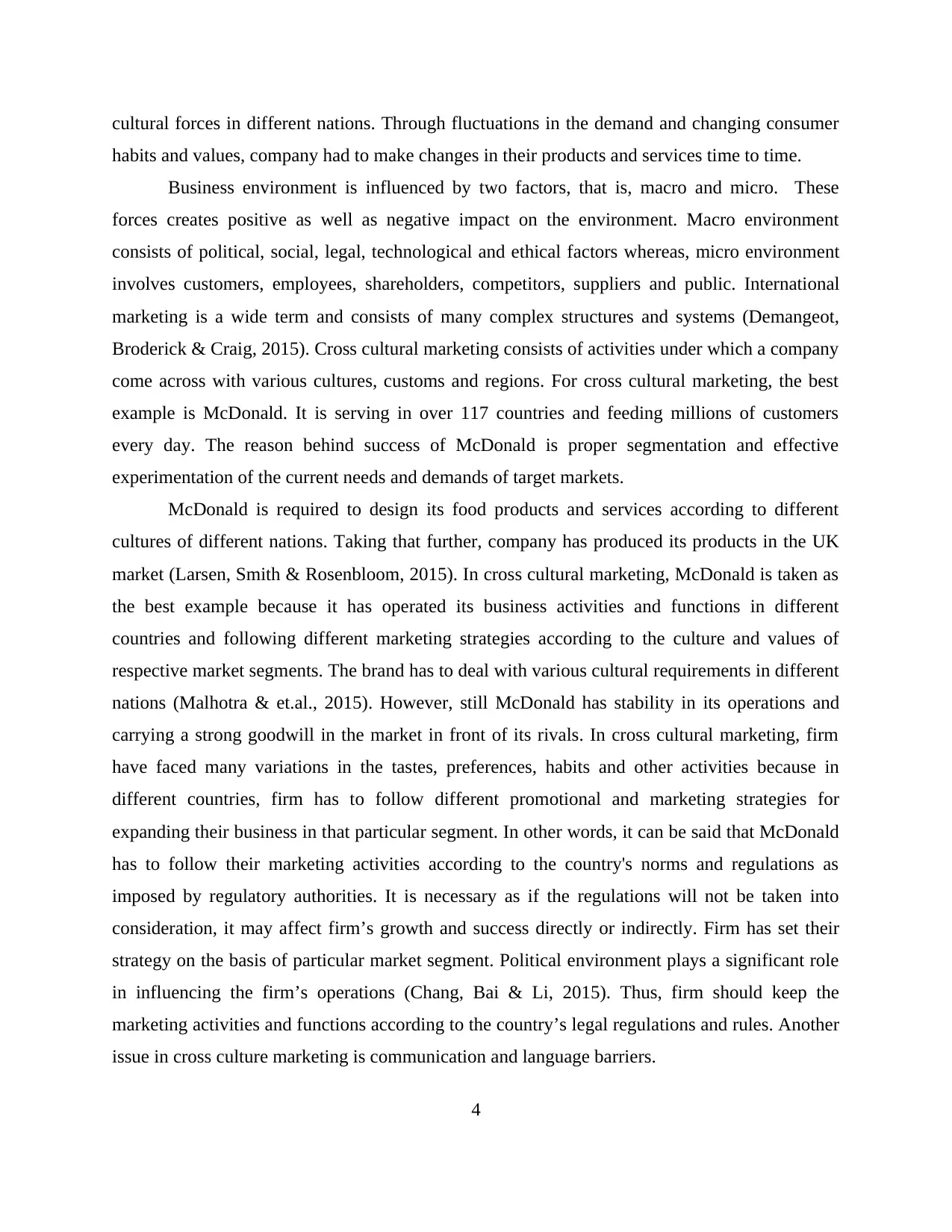
cultural forces in different nations. Through fluctuations in the demand and changing consumer
habits and values, company had to make changes in their products and services time to time.
Business environment is influenced by two factors, that is, macro and micro. These
forces creates positive as well as negative impact on the environment. Macro environment
consists of political, social, legal, technological and ethical factors whereas, micro environment
involves customers, employees, shareholders, competitors, suppliers and public. International
marketing is a wide term and consists of many complex structures and systems (Demangeot,
Broderick & Craig, 2015). Cross cultural marketing consists of activities under which a company
come across with various cultures, customs and regions. For cross cultural marketing, the best
example is McDonald. It is serving in over 117 countries and feeding millions of customers
every day. The reason behind success of McDonald is proper segmentation and effective
experimentation of the current needs and demands of target markets.
McDonald is required to design its food products and services according to different
cultures of different nations. Taking that further, company has produced its products in the UK
market (Larsen, Smith & Rosenbloom, 2015). In cross cultural marketing, McDonald is taken as
the best example because it has operated its business activities and functions in different
countries and following different marketing strategies according to the culture and values of
respective market segments. The brand has to deal with various cultural requirements in different
nations (Malhotra & et.al., 2015). However, still McDonald has stability in its operations and
carrying a strong goodwill in the market in front of its rivals. In cross cultural marketing, firm
have faced many variations in the tastes, preferences, habits and other activities because in
different countries, firm has to follow different promotional and marketing strategies for
expanding their business in that particular segment. In other words, it can be said that McDonald
has to follow their marketing activities according to the country's norms and regulations as
imposed by regulatory authorities. It is necessary as if the regulations will not be taken into
consideration, it may affect firm’s growth and success directly or indirectly. Firm has set their
strategy on the basis of particular market segment. Political environment plays a significant role
in influencing the firm’s operations (Chang, Bai & Li, 2015). Thus, firm should keep the
marketing activities and functions according to the country’s legal regulations and rules. Another
issue in cross culture marketing is communication and language barriers.
4
habits and values, company had to make changes in their products and services time to time.
Business environment is influenced by two factors, that is, macro and micro. These
forces creates positive as well as negative impact on the environment. Macro environment
consists of political, social, legal, technological and ethical factors whereas, micro environment
involves customers, employees, shareholders, competitors, suppliers and public. International
marketing is a wide term and consists of many complex structures and systems (Demangeot,
Broderick & Craig, 2015). Cross cultural marketing consists of activities under which a company
come across with various cultures, customs and regions. For cross cultural marketing, the best
example is McDonald. It is serving in over 117 countries and feeding millions of customers
every day. The reason behind success of McDonald is proper segmentation and effective
experimentation of the current needs and demands of target markets.
McDonald is required to design its food products and services according to different
cultures of different nations. Taking that further, company has produced its products in the UK
market (Larsen, Smith & Rosenbloom, 2015). In cross cultural marketing, McDonald is taken as
the best example because it has operated its business activities and functions in different
countries and following different marketing strategies according to the culture and values of
respective market segments. The brand has to deal with various cultural requirements in different
nations (Malhotra & et.al., 2015). However, still McDonald has stability in its operations and
carrying a strong goodwill in the market in front of its rivals. In cross cultural marketing, firm
have faced many variations in the tastes, preferences, habits and other activities because in
different countries, firm has to follow different promotional and marketing strategies for
expanding their business in that particular segment. In other words, it can be said that McDonald
has to follow their marketing activities according to the country's norms and regulations as
imposed by regulatory authorities. It is necessary as if the regulations will not be taken into
consideration, it may affect firm’s growth and success directly or indirectly. Firm has set their
strategy on the basis of particular market segment. Political environment plays a significant role
in influencing the firm’s operations (Chang, Bai & Li, 2015). Thus, firm should keep the
marketing activities and functions according to the country’s legal regulations and rules. Another
issue in cross culture marketing is communication and language barriers.
4
Paraphrase This Document
Need a fresh take? Get an instant paraphrase of this document with our AI Paraphraser
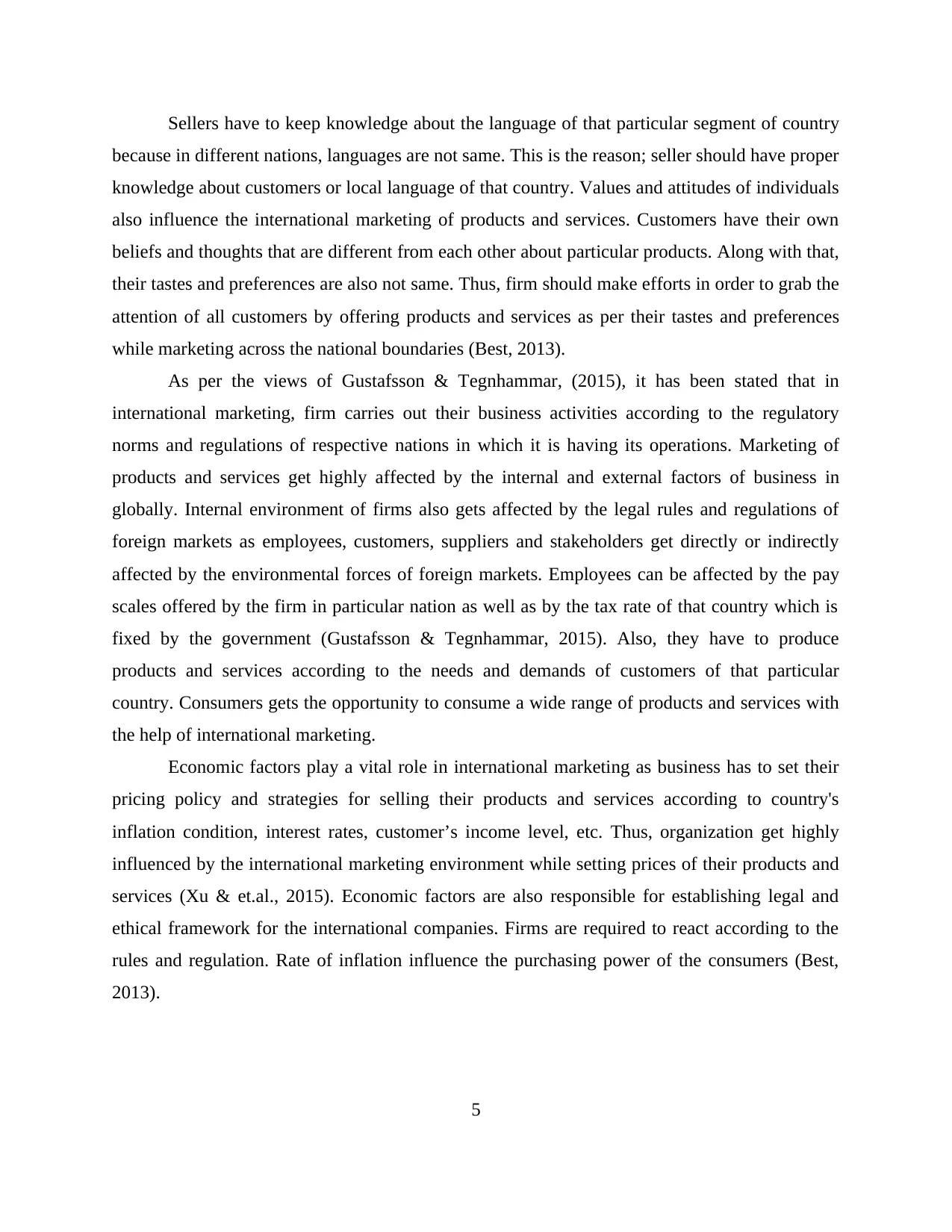
Sellers have to keep knowledge about the language of that particular segment of country
because in different nations, languages are not same. This is the reason; seller should have proper
knowledge about customers or local language of that country. Values and attitudes of individuals
also influence the international marketing of products and services. Customers have their own
beliefs and thoughts that are different from each other about particular products. Along with that,
their tastes and preferences are also not same. Thus, firm should make efforts in order to grab the
attention of all customers by offering products and services as per their tastes and preferences
while marketing across the national boundaries (Best, 2013).
As per the views of Gustafsson & Tegnhammar, (2015), it has been stated that in
international marketing, firm carries out their business activities according to the regulatory
norms and regulations of respective nations in which it is having its operations. Marketing of
products and services get highly affected by the internal and external factors of business in
globally. Internal environment of firms also gets affected by the legal rules and regulations of
foreign markets as employees, customers, suppliers and stakeholders get directly or indirectly
affected by the environmental forces of foreign markets. Employees can be affected by the pay
scales offered by the firm in particular nation as well as by the tax rate of that country which is
fixed by the government (Gustafsson & Tegnhammar, 2015). Also, they have to produce
products and services according to the needs and demands of customers of that particular
country. Consumers gets the opportunity to consume a wide range of products and services with
the help of international marketing.
Economic factors play a vital role in international marketing as business has to set their
pricing policy and strategies for selling their products and services according to country's
inflation condition, interest rates, customer’s income level, etc. Thus, organization get highly
influenced by the international marketing environment while setting prices of their products and
services (Xu & et.al., 2015). Economic factors are also responsible for establishing legal and
ethical framework for the international companies. Firms are required to react according to the
rules and regulation. Rate of inflation influence the purchasing power of the consumers (Best,
2013).
5
because in different nations, languages are not same. This is the reason; seller should have proper
knowledge about customers or local language of that country. Values and attitudes of individuals
also influence the international marketing of products and services. Customers have their own
beliefs and thoughts that are different from each other about particular products. Along with that,
their tastes and preferences are also not same. Thus, firm should make efforts in order to grab the
attention of all customers by offering products and services as per their tastes and preferences
while marketing across the national boundaries (Best, 2013).
As per the views of Gustafsson & Tegnhammar, (2015), it has been stated that in
international marketing, firm carries out their business activities according to the regulatory
norms and regulations of respective nations in which it is having its operations. Marketing of
products and services get highly affected by the internal and external factors of business in
globally. Internal environment of firms also gets affected by the legal rules and regulations of
foreign markets as employees, customers, suppliers and stakeholders get directly or indirectly
affected by the environmental forces of foreign markets. Employees can be affected by the pay
scales offered by the firm in particular nation as well as by the tax rate of that country which is
fixed by the government (Gustafsson & Tegnhammar, 2015). Also, they have to produce
products and services according to the needs and demands of customers of that particular
country. Consumers gets the opportunity to consume a wide range of products and services with
the help of international marketing.
Economic factors play a vital role in international marketing as business has to set their
pricing policy and strategies for selling their products and services according to country's
inflation condition, interest rates, customer’s income level, etc. Thus, organization get highly
influenced by the international marketing environment while setting prices of their products and
services (Xu & et.al., 2015). Economic factors are also responsible for establishing legal and
ethical framework for the international companies. Firms are required to react according to the
rules and regulation. Rate of inflation influence the purchasing power of the consumers (Best,
2013).
5
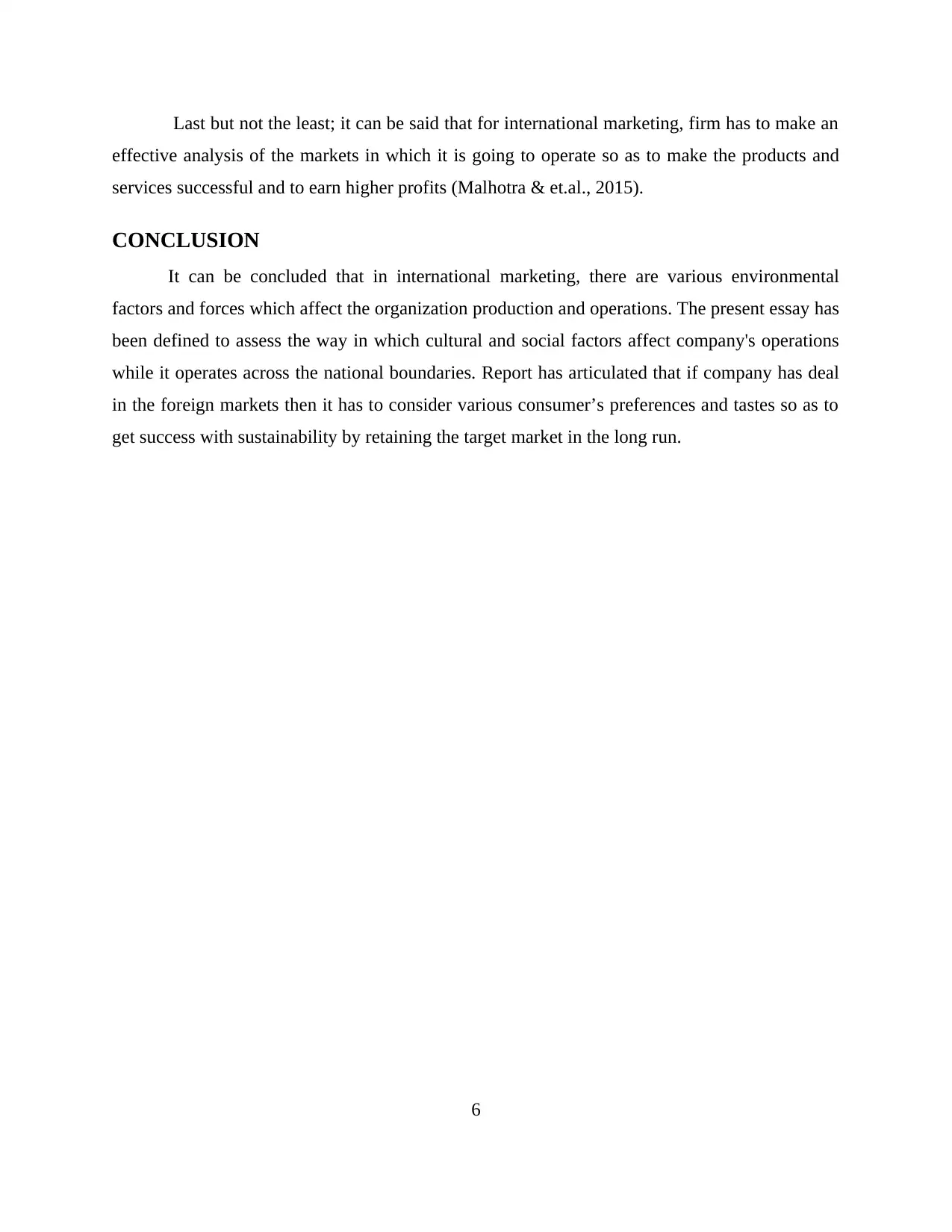
Last but not the least; it can be said that for international marketing, firm has to make an
effective analysis of the markets in which it is going to operate so as to make the products and
services successful and to earn higher profits (Malhotra & et.al., 2015).
CONCLUSION
It can be concluded that in international marketing, there are various environmental
factors and forces which affect the organization production and operations. The present essay has
been defined to assess the way in which cultural and social factors affect company's operations
while it operates across the national boundaries. Report has articulated that if company has deal
in the foreign markets then it has to consider various consumer’s preferences and tastes so as to
get success with sustainability by retaining the target market in the long run.
6
effective analysis of the markets in which it is going to operate so as to make the products and
services successful and to earn higher profits (Malhotra & et.al., 2015).
CONCLUSION
It can be concluded that in international marketing, there are various environmental
factors and forces which affect the organization production and operations. The present essay has
been defined to assess the way in which cultural and social factors affect company's operations
while it operates across the national boundaries. Report has articulated that if company has deal
in the foreign markets then it has to consider various consumer’s preferences and tastes so as to
get success with sustainability by retaining the target market in the long run.
6
⊘ This is a preview!⊘
Do you want full access?
Subscribe today to unlock all pages.

Trusted by 1+ million students worldwide
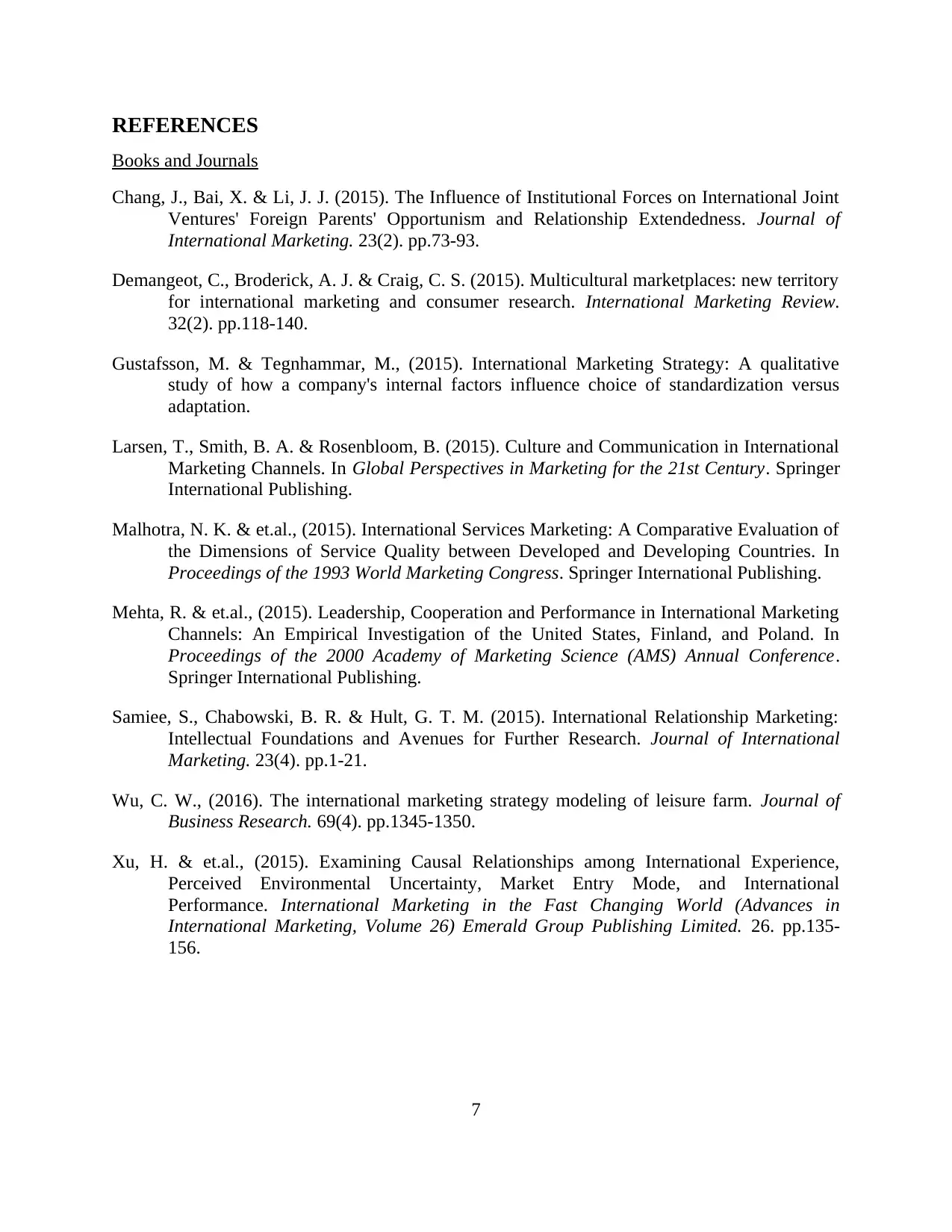
REFERENCES
Books and Journals
Chang, J., Bai, X. & Li, J. J. (2015). The Influence of Institutional Forces on International Joint
Ventures' Foreign Parents' Opportunism and Relationship Extendedness. Journal of
International Marketing. 23(2). pp.73-93.
Demangeot, C., Broderick, A. J. & Craig, C. S. (2015). Multicultural marketplaces: new territory
for international marketing and consumer research. International Marketing Review.
32(2). pp.118-140.
Gustafsson, M. & Tegnhammar, M., (2015). International Marketing Strategy: A qualitative
study of how a company's internal factors influence choice of standardization versus
adaptation.
Larsen, T., Smith, B. A. & Rosenbloom, B. (2015). Culture and Communication in International
Marketing Channels. In Global Perspectives in Marketing for the 21st Century. Springer
International Publishing.
Malhotra, N. K. & et.al., (2015). International Services Marketing: A Comparative Evaluation of
the Dimensions of Service Quality between Developed and Developing Countries. In
Proceedings of the 1993 World Marketing Congress. Springer International Publishing.
Mehta, R. & et.al., (2015). Leadership, Cooperation and Performance in International Marketing
Channels: An Empirical Investigation of the United States, Finland, and Poland. In
Proceedings of the 2000 Academy of Marketing Science (AMS) Annual Conference.
Springer International Publishing.
Samiee, S., Chabowski, B. R. & Hult, G. T. M. (2015). International Relationship Marketing:
Intellectual Foundations and Avenues for Further Research. Journal of International
Marketing. 23(4). pp.1-21.
Wu, C. W., (2016). The international marketing strategy modeling of leisure farm. Journal of
Business Research. 69(4). pp.1345-1350.
Xu, H. & et.al., (2015). Examining Causal Relationships among International Experience,
Perceived Environmental Uncertainty, Market Entry Mode, and International
Performance. International Marketing in the Fast Changing World (Advances in
International Marketing, Volume 26) Emerald Group Publishing Limited. 26. pp.135-
156.
7
Books and Journals
Chang, J., Bai, X. & Li, J. J. (2015). The Influence of Institutional Forces on International Joint
Ventures' Foreign Parents' Opportunism and Relationship Extendedness. Journal of
International Marketing. 23(2). pp.73-93.
Demangeot, C., Broderick, A. J. & Craig, C. S. (2015). Multicultural marketplaces: new territory
for international marketing and consumer research. International Marketing Review.
32(2). pp.118-140.
Gustafsson, M. & Tegnhammar, M., (2015). International Marketing Strategy: A qualitative
study of how a company's internal factors influence choice of standardization versus
adaptation.
Larsen, T., Smith, B. A. & Rosenbloom, B. (2015). Culture and Communication in International
Marketing Channels. In Global Perspectives in Marketing for the 21st Century. Springer
International Publishing.
Malhotra, N. K. & et.al., (2015). International Services Marketing: A Comparative Evaluation of
the Dimensions of Service Quality between Developed and Developing Countries. In
Proceedings of the 1993 World Marketing Congress. Springer International Publishing.
Mehta, R. & et.al., (2015). Leadership, Cooperation and Performance in International Marketing
Channels: An Empirical Investigation of the United States, Finland, and Poland. In
Proceedings of the 2000 Academy of Marketing Science (AMS) Annual Conference.
Springer International Publishing.
Samiee, S., Chabowski, B. R. & Hult, G. T. M. (2015). International Relationship Marketing:
Intellectual Foundations and Avenues for Further Research. Journal of International
Marketing. 23(4). pp.1-21.
Wu, C. W., (2016). The international marketing strategy modeling of leisure farm. Journal of
Business Research. 69(4). pp.1345-1350.
Xu, H. & et.al., (2015). Examining Causal Relationships among International Experience,
Perceived Environmental Uncertainty, Market Entry Mode, and International
Performance. International Marketing in the Fast Changing World (Advances in
International Marketing, Volume 26) Emerald Group Publishing Limited. 26. pp.135-
156.
7
Paraphrase This Document
Need a fresh take? Get an instant paraphrase of this document with our AI Paraphraser
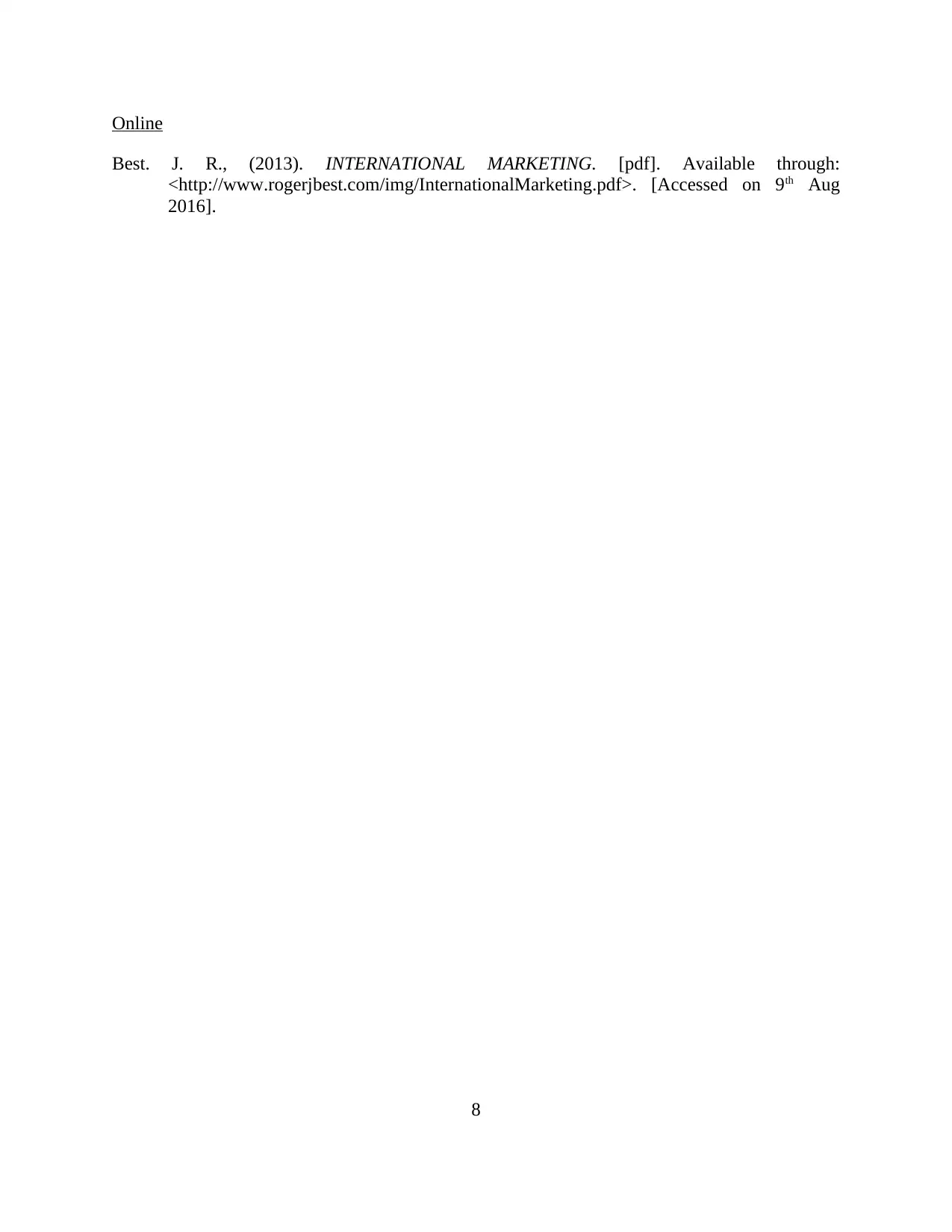
Online
Best. J. R., (2013). INTERNATIONAL MARKETING. [pdf]. Available through:
<http://www.rogerjbest.com/img/InternationalMarketing.pdf>. [Accessed on 9th Aug
2016].
8
Best. J. R., (2013). INTERNATIONAL MARKETING. [pdf]. Available through:
<http://www.rogerjbest.com/img/InternationalMarketing.pdf>. [Accessed on 9th Aug
2016].
8
1 out of 8
Related Documents
Your All-in-One AI-Powered Toolkit for Academic Success.
+13062052269
info@desklib.com
Available 24*7 on WhatsApp / Email
![[object Object]](/_next/static/media/star-bottom.7253800d.svg)
Unlock your academic potential
Copyright © 2020–2025 A2Z Services. All Rights Reserved. Developed and managed by ZUCOL.




